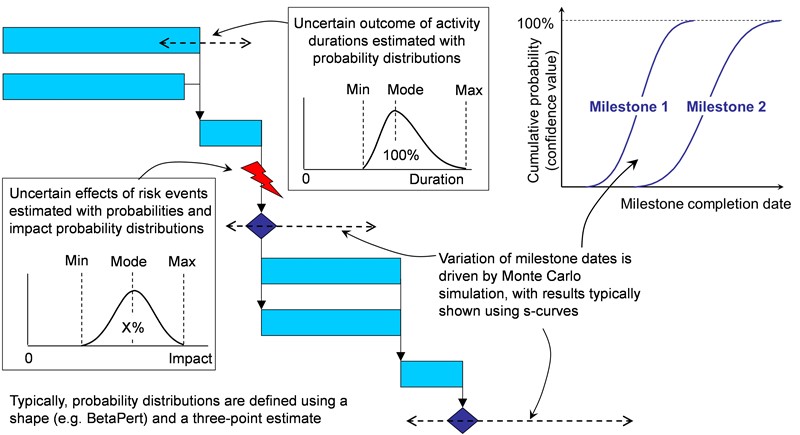A brief guide
Practical Project Risk Management
SERIES ARTICLE
By Martin Hopkinson
United Kingdom
Purposes
- Forecast the effects of risk on the date of project completion and key milestone dates.
- Identify the activities and risks likely to cause the most variance to schedule performance.
- Quantify and plan appropriate provisions for schedule contingency.
- Contribute to the quantification of cost risks that are influenced by schedule performance.
Illustration of a Monte Carlo Schedule Risk Model
A Monte Carlo schedule risk model comprises a network of activities (of uncertain duration) and risk events (with probability and impact estimates) that can be used to simulate variations of schedule duration. The main analysis outputs focus on final and interim milestones.

Other Potential Inputs and Outputs
In addition to the inputs illustrated in the figure, schedule risk models may include:
- Start-no-earlier constraint dates (but only where there is a genuine justification for them).
- Correlation between the inputs for activity duration (particularly for larger models).
- Probabilistic or conditional dependencies.
- Probabilistic calendars e.g. to simulate the effects of date-dependent weather risks.
- Resource constraints and/or probabilistic variance in resource availability.
In addition to the simulated variation of milestone completion dates, statistical outputs from a schedule model can be used to identify the activities and risks that drive schedule risk.
More…
To read entire article, click here
Editor’s note: This series of articles is by Martin Hopkinson, author of the books “The Project Risk Maturity Model” and “Net Present Value and Risk Modelling for Projects” and contributing author for Association for Project Management (APM) guides such as Directing Change and Sponsoring Change. These articles are based on a set of short risk management guides previously available on his company website, now retired. For an Introduction and context for this series, click here. Learn more about Martin Hopkinson in his author profile below.
How to cite this paper: Hopkinson, M. (2023). Schedule Risk Analysis: A brief guide, Practical Project Risk Management series, PM World Journal, Vol. XII, Issue V, May. Available online at https://pmworldlibrary.net/wp-content/uploads/2023/05/pmwj129-May-2023-Hopkinson-schedule-risk-analysis-risk-management-article.pdf
About the Author

Martin Hopkinson
United Kingdom
![]()
Martin Hopkinson, recently retired as the Director of Risk Management Capability Limited in the UK, and has 30 years’ experience as a project manager and project risk management consultant. His experience has been gained across a wide variety of industries and engineering disciplines and includes multibillion-pound projects and programmes. He was the lead author on Tools and Techniques for the Association for Project Management’s (APM) guide to risk management (The PRAM Guide) and led the group that produced the APM guide Prioritising Project Risks.
Martin’s first book, The Project Risk Maturity Model, concerns the risk management process. His contributions to Association for Project Management (APM) guides such as Directing Change and Sponsoring Change reflect his belief in the importance of project governance and business case development.
In his second book Net Present Value and Risk Modelling for Projects he brought these subjects together by showing how NPV and risk modelling techniques can be used to optimise projects and support project approval decisions. (To learn more about the book, click here.)
To view other works by Martin Hopkinson, visit his author showcase in the PM World Library at https://pmworldlibrary.net/authors/martin-hopkinson/









